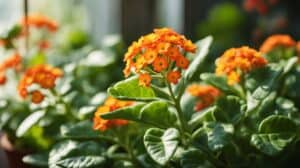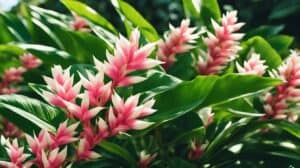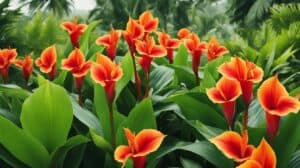Dionaea Muscipula, commonly known as the Venus Flytrap, is a fascinating plant that has captured the imagination of many.
Known for its carnivorous tendencies, the Venus Flytrap has a unique ability to trap and digest insects, making it a popular choice among plant enthusiasts.
For those who are new to the world of Venus Flytraps, there are a few things to keep in mind to ensure that your plant thrives.

One of the most important things to understand about Venus Flytraps is their natural habitat.
These plants are native to the wetlands of the southeastern United States, where they grow in acidic soil with high levels of moisture.
When growing a Venus Flytrap, it is important to replicate these conditions as closely as possible to ensure that your plant stays healthy.
Another important factor to consider when caring for a Venus Flytrap is its diet.
While these plants are capable of catching and digesting insects, they still require proper nutrition to thrive.
In addition to insects, Venus Flytraps also require a nutrient-rich soil, and may benefit from occasional fertilization.
With the right care and attention, a Venus Flytrap can be a captivating addition to any plant collection.
Understanding Dionaea Muscipula
Species Overview
Dionaea Muscipula, commonly known as the Venus Flytrap, is a carnivorous plant native to the wetlands of the Southeastern United States.
It is a small plant, growing up to 5 inches tall and 4 inches wide.
The leaves of the plant are modified into traps, which are triggered by the movement of tiny hairs on the surface of the leaves.
When an insect or other small prey touches the hairs, the trap snaps shut, trapping the prey inside.
The plant then secretes digestive enzymes to break down the prey and absorb its nutrients.
The Venus Flytrap has become a popular plant for enthusiasts due to its unique and fascinating ability to catch and digest insects.
It is also a popular subject for scientific research, as it is one of the few plants that can actively capture and digest prey.
Natural Habitat
The Venus Flytrap is found in the wetlands of the Southeastern United States, primarily in North and South Carolina.
It grows in nutrient-poor soil and relies on catching insects for its nutrients.
The plant prefers full sun and high humidity, and can survive in temperatures ranging from 20 to 100 degrees Fahrenheit.
Due to its popularity, the Venus Flytrap has been introduced to other parts of the world, but it is important to note that it is an endangered species in its natural habitat.
It is illegal to collect Venus Flytraps from the wild, and enthusiasts are encouraged to purchase plants from reputable nurseries to ensure the conservation of the species.
Overall, the Venus Flytrap is a fascinating and unique plant that has captured the imagination of people around the world.
With proper care and attention, it can be a rewarding addition to any plant collection.
Caring for Your Venus Flytrap

Soil Requirements
Venus Flytraps require a specific type of soil to thrive. The soil should be a mixture of sphagnum moss and perlite or sand.
The moss helps to keep the soil moist, while the perlite or sand provides drainage.
Avoid using regular potting soil, as it is too rich in nutrients and can harm the plant.
Watering Techniques
It is important to keep the soil moist at all times, but avoid overwatering as it can lead to root rot.
Use distilled or rainwater to water your Venus Flytrap, as tap water can contain minerals that can harm the plant.
Water the plant from the bottom by placing it in a tray of water and allowing it to soak up the water for 10-15 minutes.
Sunlight and Temperature
Venus Flytraps require full sun to grow properly. They should be placed in a south-facing window or outside in direct sunlight.
The ideal temperature range for Venus Flytraps is between 70-85°F during the day and 50-60°F at night.
Avoid exposing the plant to temperatures below 40°F or above 95°F.
Feeding Practices
Venus Flytraps are carnivorous and require insects to survive.
They can catch their own prey, but you can also feed them small insects such as flies or crickets.
Do not feed them anything larger than 1/3 of the size of the trap, as it can damage the plant.
Only feed them once a week during the growing season, and stop feeding them during the winter months when they go dormant.
By following these simple care instructions, your Venus Flytrap will thrive and provide you with hours of captivating entertainment.
Propagation and Repotting

Seed Propagation
One of the most exciting ways to propagate Venus Flytraps is through seeds.
It’s important to note that it can take up to 3-5 years for the plant to reach maturity and produce traps.
To begin, gather fresh Venus Flytrap seeds and plant them in a mix of peat moss and perlite.
Keep the soil moist and place the container in a warm and bright location, but out of direct sunlight.
Once the seedlings have grown to a reasonable size, they can be transplanted into their own pots.
It’s important to be careful when handling the fragile roots of the seedlings. Repot them in a mix of peat moss and sand and keep the soil moist.
Division Method
Another way to propagate Venus Flytraps is through division. This method involves separating the plant into smaller sections and replanting them.
To begin, remove the plant from its pot and gently separate the roots into smaller sections, making sure each section has its own roots and leaves.
Repot each section in a mix of peat moss and sand and keep the soil moist.
It’s important to note that Venus Flytraps can be sensitive to transplant shock, so it’s best to avoid disturbing the roots as much as possible.
Repotting Venus Flytraps is also important to ensure their health and growth.
It’s recommended to repot the plant once a year in fresh soil to prevent nutrient depletion and root rot.
When repotting, gently remove the plant from its pot and carefully separate any tangled roots. Repot the plant in fresh soil and water thoroughly.
By following these propagation and repotting tips, beginners can enjoy the captivating world of Venus Flytraps and watch them thrive.
Troubleshooting Common Issues

Pest Infestations
Venus Flytraps are carnivorous plants that attract insects with their sweet nectar.
However, sometimes they can attract unwanted pests that can harm the plant.
Common pests that can infest Venus Flytraps include spider mites, aphids, and mealybugs. These pests can cause damage to the leaves and weaken the plant.
To combat these pests, it is recommended to regularly inspect the plant and remove any visible pests with a pair of tweezers or a cotton swab dipped in rubbing alcohol.
It is also important to keep the plant in a clean environment and avoid overwatering, as stagnant water can attract pests.
Diseases and Disorders
Like all plants, Venus Flytraps can be susceptible to diseases and disorders.
One common disorder is “blackening,” where the leaves turn black and die off.
This can be caused by overfeeding, overwatering, or exposure to extreme temperatures.
To prevent blackening, it is important to provide the plant with the appropriate amount of water and avoid overfeeding.
If the plant is exposed to extreme temperatures, it should be moved to a more suitable location.
Another disease that can affect Venus Flytraps is fungal infections. These can be caused by overwatering or exposure to high humidity.
To prevent fungal infections, it is important to allow the soil to dry out between waterings and to avoid placing the plant in a location with high humidity.
Environmental Stressors
Venus Flytraps are native to the wetlands of the southeastern United States and require a specific environment to thrive.
Environmental stressors such as inadequate lighting, low humidity, and extreme temperatures can cause the plant to weaken and become more susceptible to pests and diseases.
To prevent environmental stress, it is important to provide the plant with the appropriate amount of light, humidity, and temperature.
Venus Flytraps require bright, indirect sunlight and a humidity level of at least 50%. They also prefer temperatures between 70-85°F (21-29°C).
If the plant is not receiving the appropriate amount of light, humidity, or temperature, it should be moved to a more suitable location.
Frequently Asked Questions

What are the ideal growing conditions for a Venus Flytrap?
Venus Flytraps thrive in bright, direct sunlight for at least four hours a day. They also require a moist, well-draining soil that is low in nutrients.
A mixture of sphagnum peat moss and perlite is a great option.
Venus Flytraps also prefer a humid environment, so placing a tray of water near the plant or misting it regularly can be helpful.
How often should I water my Venus Flytrap, and what type of water is best?
Venus Flytraps should be watered with distilled or rainwater, as tap water can contain minerals that are harmful to the plant.
It’s important to keep the soil moist, but not waterlogged.
A good rule of thumb is to water the plant when the top layer of soil feels dry to the touch.
What should I feed my Venus Flytrap, and how frequently?
Venus Flytraps feed on insects, and should not be given anything other than live insects. Common options include small flies, ants, and spiders.
It’s important to not overfeed the plant, as this can lead to problems with digestion.
A general rule is to feed the plant one or two insects per week during the growing season.
Can Venus Flytraps live indoors, and if so, what are the care tips?
Venus Flytraps can live indoors, but they require bright, direct sunlight for at least four hours a day.
They also need a humid environment, so placing a tray of water near the plant or misting it regularly can be helpful.
It’s important to not let the soil dry out completely, but also to not overwater the plant.
How do I repot a Venus Flytrap, and when is the best time to do it?
Venus Flytraps should be repotted every year or two, depending on the size of the plant and the pot.
The best time to repot is in the spring, before the growing season begins.
To repot, gently remove the plant from its current pot and carefully separate the roots. Place the plant in a new pot with fresh soil.
What are common issues to watch out for when caring for a Venus Flytrap?
Overwatering and underwatering are common issues when caring for a Venus Flytrap. It’s important to keep the soil moist, but not waterlogged.
Another issue is feeding the plant too much, which can lead to problems with digestion.
Venus Flytraps are also sensitive to chemicals, so avoid using any pesticides or fertilizers on or near the plant.














